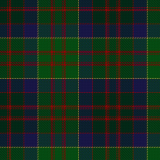Tartan of Barbecue Presbyterian Church

When one thinks of Scotland, many iconic images come to mind; rolling green hills, ancient castles, and Nessie swimming in her loch.
Even more memorable than these, however, is the patterned fabric which has come to symbolize Scottish culture itself: Tartan is the only textile design in the world of which a tiny scrap can evoke such feelings of pride, such identification with the historical struggles of Scots, and identification with those desirable traits associated with being Scottish - honesty, industriousness and bravery in battle.*
Although tartan-style fabrics have a very long history – a good portion of it not Scottish – today these textiles are most famous as badges of identification. Specific colors and their arrangements function as a symbolic language in their own right, representing individuals, families and clans, as well as professional groups, companies, and organizations. To the huge international family of Scots and their descendants - estimated at 40 to 60 million around the globe - tartan represents everything that is admirable and wholesome about the land of their fathers.*
Barbecue Presbyterian Church, located in Sandford, North Carolina, was founded in 1758 by Scottish Presbyterians who left Jura, Skye and the Presbytery of Inverary in 1739 to sail to America. It was Barbecue Church that issued the first call in North Carolina to a Presbyterian minister, who came and settled in the area. This tartan was designed for the 250th anniversary of the church. It is based on the MacDonald tartan, as Flora MacDonald attended this church while living with her half-sister, Anna Bella MacDonald. The church's web site is www.barbecuech1758.org.**
*http://www.tartansauthority.com/tartan/
**https://www.tartanregister.gov.uk/tartanDetails?ref=5537
© Symbols.com
